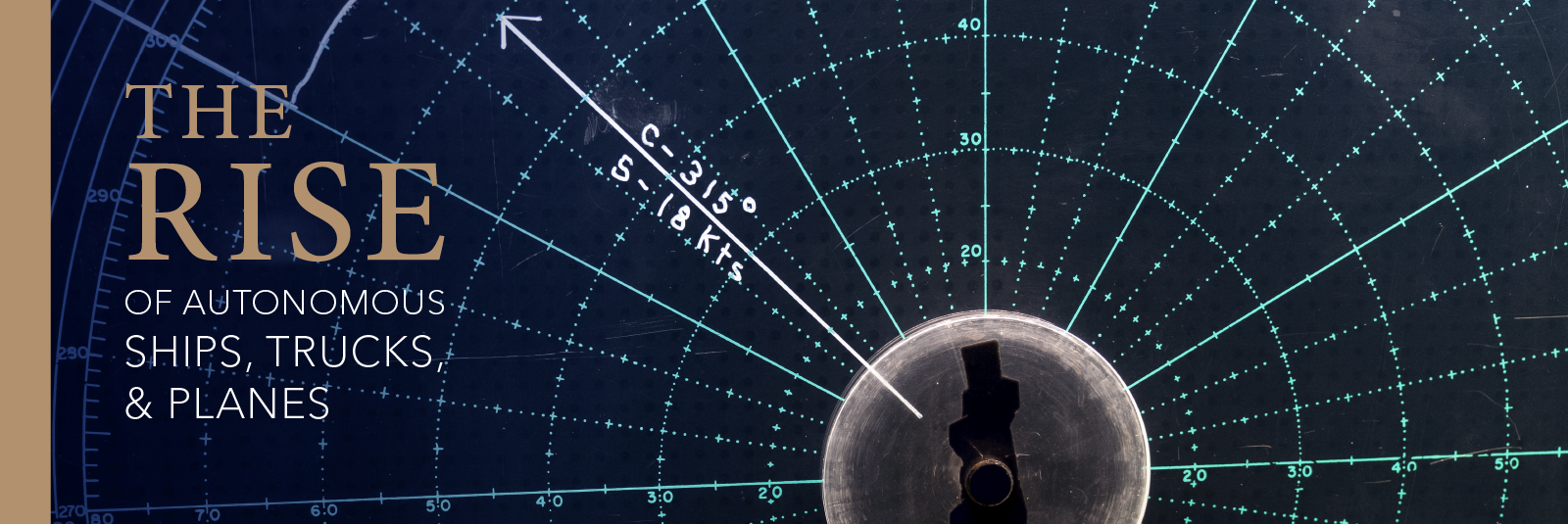Automation is here, and likely here to stay. Of paramount importance for insureds and brokers is understanding how automation technologies will change—in potentially rapid and disruptive ways—how freight is transported by ship, truck, and plane. Here’s a quick summary of the recent developments in sea, land, and air:
Autonomous Ships
The global push to create an all-electric and autonomous container ship is on. Rolls-Royce’s Advanced Autonomous Waterborne Applications (AAWA), the EU’s Maritime Unmanned Navigation through Intelligence in Networks (MUNIN) project, and the Finnish One Sea ecosystem are just a few high-profile examples. Advances in the Internet of Things—combined with improved decision-making algorithms, cyber-security, and energy management—suggest networked fleets of unmanned surface and underwater shipping vessels will be viable within the next decade.
The commercial benefits of autonomous ships are being touted as improved efficiency, reduced emissions, and lower-cost operations. However, a lack of skilled labor and the high capital expenditure currently required to engineer such vessels remain mitigating factors in development. A further consideration is the 25-year lifespan of most maritime shipping vessels. It’s debatable whether the advantages of autonomous ships will outweigh the costs of having to scrap a vessel that’s still technically viable.
Autonomous Vehicles
Commercial trucking is another area ripe for disruption by automated technologies. Port operations and private property, in particular, are proving to be a natural starting place for applying these technologies because of the relative safety and simplicity of these controlled environments.
Autonomous long-haul trucking is also expected to take over the roadways, with companies such as Uber, Otto, and Chinese giant Baidu already testing self-driving trucks. The benefits of autonomy include faster shipments, fewer accidents, and lower costs using tactics like vehicle “platooning” —when multiple autonomous trucks drive closely together to “draft” off one another and reduce fuel usage. Additionally, the industry is facing a shortage of drivers, so autonomous trucks could be a welcome solution.
Yet certain challenges remain. The sheer weight of commercial trucks is one aspect limiting widespread automation. Heavy semi trucks take more time to stop than do cars, and are less able to swerve. Unpredictable weather conditions also provide significant challenges. More miles traveled at lower costs remains the goal, however, and once safety concerns are allayed, automated commercial shipping in the U.S. is expected to increase as it has in China.
Autonomous Aircraft
There is also much speculation around the ways autonomous drones and other unmanned aerial vehicles (UAVs) will disrupt the shipping industry. While commercial airline passengers might not be ready for planes without pilots, cargo planes have a lot to gain from autonomous technology. With drones now able to lift the equivalent of two baby elephants (and with aerial shipping already highly reliant on auto-pilot and other sensor-driven automated technologies), the time is likely not far off when UAVs will become a regular part of supply chains.
Weather conditions will likely be a mitigating factor for the time being (humans are still better at deciding when bad weather requires a plane to land, for example) and there is a risk that automated planes will lead to a lack of trained human pilots. But industries—especially shipping industries—continue to pursue automated technologies, and demand is only expected to grow.
Further challenges to shipping autonomy include safety considerations, integration with existing assets and systems, the regulatory environment, and a host of engineering complexities required to decrease fallibility of both the shipping vessels and the people designing them.
Regardless of the challenges, automation will disrupt the shipping industry sooner or later, and with change will come opportunity, be it by air, by road or by sea.




